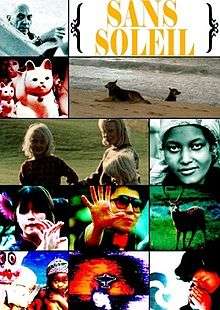Sans Soleil
| Sans Soleil | |
|---|---|
 Film poster | |
| Directed by | Chris Marker |
| Written by | Chris Marker (as Sandor Krasna) |
| Narrated by |
Florence Delay (French version) Riyoko Ikeda (Japanese version) Charlotte Kerr (German version) Alexandra Stewart (English version) |
| Music by | Chris Marker (as Michel Krasna) |
| Cinematography | Chris Marker (as Sandor Krasna) |
| Edited by | Chris Marker |
| Distributed by | Argos Films |
Release dates |
|
Running time | 100 minutes |
| Country | France |
| Language | French |
Sans Soleil (French pronunciation: [sɑ̃ sɔ.lɛj], "Sunless") is a 1983 French documentary directed by Chris Marker, a meditation on the nature of human memory, showing the inability to recall the context and nuances of memory, and how, as a result, the perception of personal and global histories is affected. In a 2014 Sight and Sound poll, film critics voted Sans Soleil the third best documentary film of all time.[1] The title Sans Soleil is from the song cycle Sunless by Modest Mussorgsky.
Description
Expanding the documentary genre, this experimental essay-film is a composition of thoughts, images and scenes, mainly from Japan and Guinea-Bissau, "two extreme poles of survival".[2] Some other scenes were filmed in Cape Verde, Iceland, Paris, and San Francisco. A female narrator reads from letters supposedly sent to her by the (fictitious) cameraman Sandor Krasna.
Sans Soleil is often labeled a documentary, travelogue, or essay-film. Despite the film's modest use of fictional content, it should not be confused with a mockumentary (mock documentary). The fictional content derived from the juxtaposition of narrative and image adds meaning to the film along with occasional nondescript movement between locations and lack of character-based narrative.
Chris Marker has said: "On a more matter-of-fact level, I could tell you that the film intended to be, and is nothing more than a home movie. I really think that my main talent has been to find people to pay for my home movies. Were I born rich, I guess I would have made more or less the same films, at least the traveling kind, but nobody would have heard of them except my friends and visitors."[3]
Introductory quotations
The original French version of Sans Soleil opens with the following quotation by Jean Racine from the second preface to his tragedy Bajazet (1672):
"L'éloignement des pays répare en quelque sorte la trop grande proximité des temps."
(The distance between the countries compensates somewhat for the excessive closeness of the times.)
Marker replaced this quote with the following one by T. S. Eliot from Ash Wednesday (1930) for the English version of the film:
"Because I know that time is always timeAnd place is always and only place"...
And only for one place.)[4]
(And what is actual is actual only for one time
Production
Sans Soleil contains some stock footage, clips from Japanese films and television, and a few excerpts from other films. The original documentary footage was filmed by Marker with a 16mm Beaulieu silent film camera in conjunction with a non-sync portable tape recorder; the film contains no synchronous sound.[5] Some of the stock footage shots were colourized with a Spectron video synthesizer. A number of sequences in Sans Soleil are borrowed from other filmmakers who are not mentioned until the film's credits, except the footage of the Icelandic volcano which is accredited in narration to Haroun Tazieff.[6]
The filmmakers whose footage was used who were not mentioned in the narration are Sana Na N'Hada, Jean-Michel Humeau, Mario Marret, Eugenio Bentivoglio and Daniele Tessier. Pierre Camus was an assistant director; Anne-Marie L 'Hote and Catherine Adda, assistant editors; Antoine Bonfanti and Paul Bertault, mixing.[7]
The film was assembled largely in the 1970s, a period when Marker was part of a political commune and preferred to downplay his authorial signature, which may partly explain why he is represented in the film by Sandor Krasna's letters. The title "Conception and editing: Chris Marker," at the end of the credits, is the only indication that Sans Soleil is his film.[8]
Influences
The sequence in San Francisco references Alfred Hitchcock's Vertigo and Marker's own earlier film La jetée. Marker's use of the name "The Zone" to describe the space in which Hayao Yamaneko's images are transformed is a homage to Stalker, a film by Andrei Tarkovsky, as noted in one of the letters read in the film. English rock band Kasabian used a sound clip from the documentary in their West Ryder Pauper Lunatic Asylum album at the beginning of the song "West Ryder Silver Bullet".
References
- ↑ "Silent film tops documentary poll". BBC News. Retrieved 1 August 2014.
- ↑ http://www.criterion.com/current/posts/484
- ↑ http://chrismarker.org/chris-marker/notes-to-theresa-on-sans-soleil-by-chris-marker
- ↑ "Racine/Eliot" from booklet accompanying La Jetée/Sans Soleil DVD produced by Criterion
- ↑ "Notes on Filmmaking", essay by Chris Marker in booklet accompanying La Jetée/Sans Soleil DVD produced by Criterion
- ↑ Lupton, Catherine (2006). Chris Marker : memories of the future (Repr. ed.). London: Reaktion Books. p. 156. ISBN 978-1861892232.
- ↑ Len. (1983, Apr 13). Pictures: Sans soleil. Variety (Archive: 1905–2000), 310, 20. Retrieved from http://search.proquest.com/docview/1438388986
- ↑ . JSTOR 4384052. Missing or empty
|title=(help)
External links
| Wikiquote has quotations related to: Sans Soleil |
- Sans Soleil at the Internet Movie Database
- Sans Soleil at Rotten Tomatoes
- Sans Soleil at AllMovie
- Full text of the film